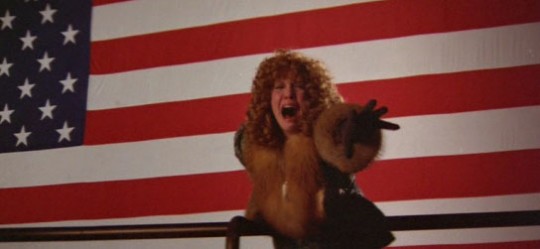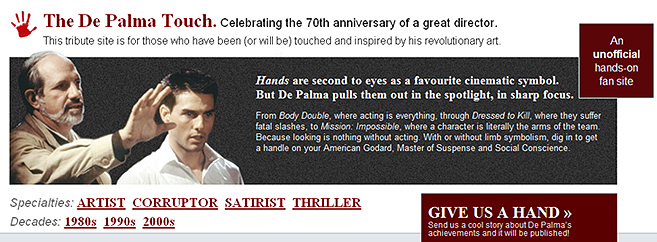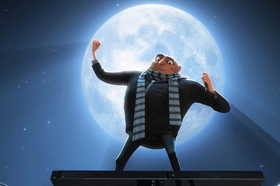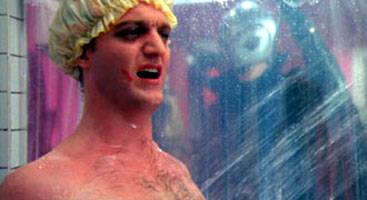ESSAYS ON BLOW OUT
HAPPY INDEPENDENCE DAY "Mr. Peel"
"Mr. Peel" attended last month's
Brian De Palma double feature of
Blow Out and
Femme Fatale at the New Beverly, and incidentally reports that
Eli Roth was in attendance. During the Q&A that followed
Blow Out, Roth asked editor
Paul Hirsch a question about De Palma's continued use of split screen techniques (Hirsch replied that he himself never liked the technique, "thinking it was too intellectual as opposed to emotional"). (We still love Eli Roth for
defending De Palma's Redacted to FOX News in 2007, even though he had apparently not seen the film yet.) Anyway, Mr Peel starts out wondering whether people who "dismiss
Blow Out as nothing more than an imitation of other films" have even bothered to see it. "For all that people talk about what he’s lifting from other films," writes Mr. Peel, "De Palma’s work often does feel dosed with a strong touch of the personal, whatever that may be and this seems to be the case with
Blow Out much more than usual." Mr. Peel continues:
What begins as a joke in this film—CO-ED FRENZY feels like him making his own joke of a De Palma movie as if he was giving everyone the coarsest version of all the sleaze they expected after DRESSED TO KILL—gradually transforms into something else as the director’s visual mastery takes hold. In its purely visual way of giving us information the storytelling is absolutely crystal clear in how it allows us to understand things that only a sound expert like Jack Terry can figure out, best exemplified in that simply awesome Scope shot where he pieces together in his head exactly what happened at the moment of the titular blow out. All hail Vilmos Zsigmond, while we’re at it. The economy of storytelling continues right up until the final minutes which always winds up lasting shorter than I expect it to, with just a handful of setups giving us a great amount of information but there’s no need to give us more than that. There’s hardly a wasted frame in the film. And that joke we got in those several extended takes right at the start (slightly similar to something Tobe Hooper did in THE FUNHOUSE around the same time) gradually dissolves away, a small running gag in the film that seems to be forgotten about as the world closes in on the two leads. What becomes clear on those multiple viewings is that as much as we wish Jack would do a few things differently, there’s the overwhelming feeling that nothing can be done about any of this, the shadowy ‘they’ who are actually just as paranoid about everyone else yet still powerful enough to pull the strings. Frankly, it actually becomes kind of depressing for me to go over certain parts of the film again because of this. Coming from what was at that time over seventeen years of conspiracy talk surrounding the Kennedy assassination (using iconography from both that event and Chappaquiddick) against the bogus Americana of the Liberty Bell Jubilee he muddies the water to have it both ways—a lone nut hired by the conspiracy who engineers his very own plot against the wishes of those allegedly pulling the strings.
In his final paragraph, Mr. Peel muses on the relationships between politics and art in De Palma's cinema between the cynical Blow Out in 1981, and the more "upbeat" Femme Fatale twenty years later:
Several months ago when I wrote about seeing DRESSED TO KILL at the New Beverly I mentioned how based on the screams heard right before the ending the film was still able to get that reaction. The audible response of the crowd registering just what had been done by the film’s lead character at the very end of BLOW OUT, making it clear how many people there were seeing this for the first time, was considerably different and much more complicated, just like the movie. Looking at it now I thought of De Palma as this sixties hippie, getting burnt out, observing what had been going on in all those years since Dallas. I wondered it he was maybe using this ending as a statement to finally throw in the towel on all he once cared about, essentially saying, “we tried to make things better, none of it worked, you went and elected Reagan…just go fuck yourselves.” When something like November 7, 2000 comes to mind for me I think I understand and maybe BLOW OUT is about one final attempt by a person with regrets to engage with the real world, to truly do something to change it for the better, only to find out that such a dream is futile and you can never wipe what happened in the past from your brain. As it turned out FEMME FATALE, screened second that night at the New Beverly, was the ideal chaser to come after this, in a sense transforming all these regrets into a giddy vindication—both films, after all, conclude with the one of the leads finally putting the finishing touch on what he’s creating, something he’s been searching for the entire film. The revelation at the end of the second film is of course much more ludicrous, not to mention considerably more upbeat, but it also offers the feeling that maybe it is possible for a person to find some sort of peace within a work of art that they’re attempting to create. Maybe that was a conclusion that Brian De Palma himself, who after all is an artist, was able to come to in the intervening years, long after he made this bitterly cynical film in 1981. I was in a wonderful mood after this double bill, practically dancing out of the theater, although in the days since those final seconds of BLOW OUT have stayed with me, as I suppose I knew they would. I guess that’s the whole point.
SALLY IS BLOGGER'S "FAVORITE MOVIE PROSTITUTE"
Meanwhile, this weekend Flick Sided's Scott Tunstall, inspired by the recent release Love Ranch (and the fact that he has no way to see that film at the present time), offers up Nancy Allen's Sally from Blow Out as his "favorite movie prostitute." Tunstall writes:
The world’s oldest profession has been a staple on the big screen for generations. Call girls, streetwalkers, call ‘em what you will. Everyone has a favorite type. Sometimes I prefer them to be elegant, like Inara from Serenity, who dresses as a queen and possesses the beauty of a goddess. Other times I get an itch for cheap and trashy, like Punchy from Street Smart, who dresses as a lot lizard and possesses the beauty of a toll booth operator. Like snowflakes, each is unique in their own way. However, my ideal lady of the night is a combination of the two. She’s got a little bit of class, but not too much. Her wardrobe is slutty, but not disgustingly so. And her beauty is natural, more like the girl next door, not the swimsuit model up the street. In cinema, that representation would be Sally from Brian De Palma’s vastly underrated thriller Blow Out.
Sally is played by one of my first boyhood crushes, Nancy Allen. Her healthy mound of curly strawberry blonde hair frames the face of a cherub. Her voice is slightly squeaky and she speaks with an annoying Philadelphia accent. (Being a Philly guy, that’s an incredible turn on.) Sally is so darn cute she catches the eye of a psychotic serial killer dubbed “The Liberty Bell Strangler,” creepily portrayed by John Lithgow.
In the following scene, John Travolta’s sound technician has bugged Sally and is tailing her to a meeting with the Strangler, who is pretending to be a reporter.
Unfortunately for Sally, she meets a tragic end, as do many big screen hussies. Why must we be so cruel to these hardworking ladies of questionable morals? Have we no compassion? Have we no shame? *wipes single tear from cheek and sighs*
 Paracinema's Dylan has posted some cast suggestions for a potential update of Brian De Palma's Phantom Of The Paradise (after seeing a remake listed as a future project at the IMDB). Although Dylan admits to having trouble thinking of someone for the role of Swan, the blogger has a radical suggestion for the lead role of Winslow: Lady Gaga. "It's 2010," writes Dylan. "Why couldn't a female be cast as Winslow Leach? Sure you'd have to change the character's name but that's small potatoes. Casting a woman in the role would be an interesting touch to an already great character and the (Gaga) Phantom's obsession with Phoenix could lend another layer to the story." Dylan adds that Gaga "could also help make the music in the film more contemporary and attract a huge audience to the film. And just think of the wardrobe possibilities!"
Paracinema's Dylan has posted some cast suggestions for a potential update of Brian De Palma's Phantom Of The Paradise (after seeing a remake listed as a future project at the IMDB). Although Dylan admits to having trouble thinking of someone for the role of Swan, the blogger has a radical suggestion for the lead role of Winslow: Lady Gaga. "It's 2010," writes Dylan. "Why couldn't a female be cast as Winslow Leach? Sure you'd have to change the character's name but that's small potatoes. Casting a woman in the role would be an interesting touch to an already great character and the (Gaga) Phantom's obsession with Phoenix could lend another layer to the story." Dylan adds that Gaga "could also help make the music in the film more contemporary and attract a huge audience to the film. And just think of the wardrobe possibilities!"




 The new animated film Despicable Me, which opens in theaters today, apparently includes a nod to Brian De Palma's Mission: Impossible. According to
The new animated film Despicable Me, which opens in theaters today, apparently includes a nod to Brian De Palma's Mission: Impossible. According to 

 Next month marks 30 years since Brian De Palma's Dressed To Kill caused a sensation in theaters across America. As
Next month marks 30 years since Brian De Palma's Dressed To Kill caused a sensation in theaters across America. As 
 An upcoming dramatic feature film called Phantom Love will attempt to shed light on why the city of Winnipeg was so taken with Brian De Palma's Phantom Of The Paradise in 1975. Winnipeg filmmaker Paula Kelly has displayed a consistent interest in Winnipeg history in her films. According to
An upcoming dramatic feature film called Phantom Love will attempt to shed light on why the city of Winnipeg was so taken with Brian De Palma's Phantom Of The Paradise in 1975. Winnipeg filmmaker Paula Kelly has displayed a consistent interest in Winnipeg history in her films. According to